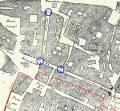The Israelitic hospital
Article Index
B) THE GHETTO
During the Middle Ages the roman Jews, mainly involved in commercial activities, did not have particular difficulties in living together the Christian population. But during the Renaissance, after the Protestant schism, the Roman Church became more coercive for the not Christian people so that in July 14th 1555 the pope Paul IV Carafa, just elected (1555-1559), revoked with the bulla “Cum nimis absurdum” all the previously granted rights and ordered to confine the about 3000 members of the Jewish community in a restricted area, the district known as Ghetto. [complete original latin text]
In order to reduce the effect of such ordinance in 1562 the new pope Pius IV (1560-1565) instituted in favor of the Jews the “Jus Gazzagà” (right of ownership) according to which the Christians kept the property of the houses located in the ghetto area, but without the right of evict the Jews who lived there nor to increase of the rent.
Originally the doors of the Ghetto were only two; in 1577 it was opened a third one. The main door was in the Giudea Square (no more existing and where it was located the fountain, the only drinkable water resource of the ghetto, just outside the fencing borders), the others two was nearby the churches of St.Angelo and St.Gregorio.
In 1589 the pope Sisto V (1585-1590) revoked some restrictions and widened the ghetto including the long building facing the Tiber river and Via della Fiumara (no more existing) at the ends of which two new doors were constructed. The ghetto reached a surface of 3 hectares. 
In the picture B1, on the base of the 1748 Nolli map, are indicated the borders, the names and the positions of the five doors and the names of the main roads of the ghetto.
After more than two centuries the excessive growth of the resident people forced the pope Leone XII (1823-1829) to allow a  further increase of the ghetto: therefore the (1825) building between Via della Reginella and Via St.Ambrogio was annexed to the ghetto opening an accessing passage between Via di Pescheria and Via Rua and adding three more doors, up to a total of eight doors (see pict.B2).
further increase of the ghetto: therefore the (1825) building between Via della Reginella and Via St.Ambrogio was annexed to the ghetto opening an accessing passage between Via di Pescheria and Via Rua and adding three more doors, up to a total of eight doors (see pict.B2).
Finally in April 17th 1848, in the evening of the 5608 Pesach, the pope Pio IX (1846-1878) ordered the opening of all the doors of the ghetto and the demolition of the walls, that however was completed only in 1885. During the construction of the new embankments of the Tiber all the buildings of the ghetto were demolish except for the building, still existing, between Via della Reginella and Via di S.Ambrogio.



